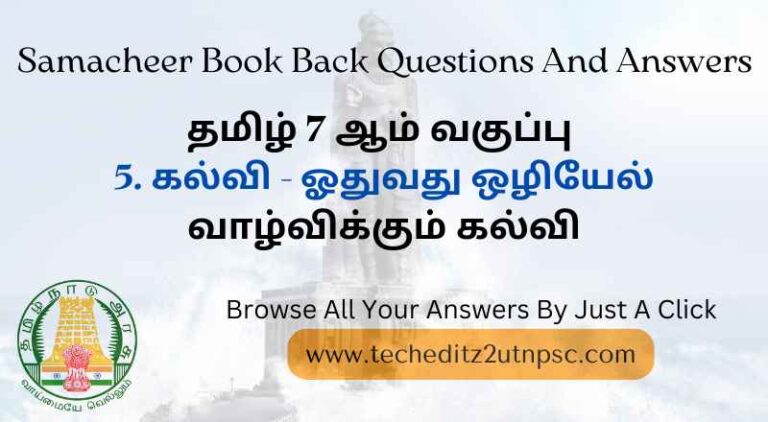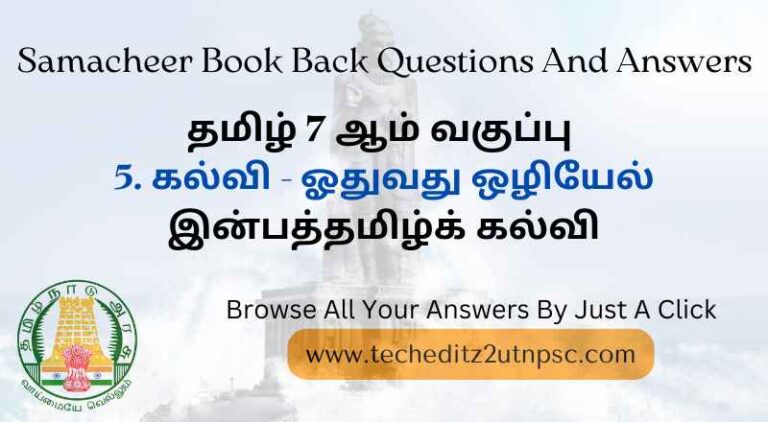support@techeditz2utnpsc.com | 8300-921-521
Employment in India and Tamil Nadu
Samacheer Book Back Questions And Answers For Economy Standard 9 Full Book “Employment in India and Tamil Nadu“
I. Choose the correct answer:
1. We take age group _____ years for computation of the workforce.
(a) 12 – 60
(b) 15 – 60
(c) 21 – 65
(d) 5 – 14
2. Which is the correct sequence of various sectors in GDP of India in the descending order?
(a) Primary sector, Secondary sector, Tertiary sector
(b) Primary sector, Tertiary sector, Secondary sector
(c) Tertiary sector, Secondary sector, Primary sector
(d) Secondary sector, Tertiary sector, Primary sector
3. Which one of the following sectors is the largest employer in India?
(a) Primary Sector
(b) Secondary Sector
(c) Tertiary Sector
(d) Public sector
4. Which one of the following is not in Primary Sector?
(a) Agriculture
(b) Manufacturing
(c) Mining
(d) Fishery
5. Which one of the following is not in the Secondary Sector?
(a) Construction
(b) Manufacturing
(c) Small Scale Industry
(d) Forestry
6. Tertiary Sector include/s _____
(a) Transport
(b) Insurance
(c) Banking
(d) All of these
7. Match the List I with List II using the codes given below:
A. Agriculture, Forestry, Fishery, Mining 1. Unorganised sector
B. Manufacturing, Electricity, Gas, Water supply 2. Service sector
C. Trade, Transport, Communication 3. Secondary sector
D. Unicorporated Enterprises, Household industries 4. Primary sector
(a) 1234
(b) 4321
(c) 2314
(d) 3241
8. Which sector is not included in the occupational pattern?
(a) Primary sector
(b) Secondary sector
(c) Tertiary sector
(d) Private sector
9. Which Delhi Sultan of medieval India formed ‘Employment Bureau’ to solve the un-employment problem?
(a) Muhamad Bin Tugluq
(b) Allauddin Khilji
(c) Feroz Shah Tugluq
(d) Balban
10. _____ sector is registered and follows government rules.
(a) Agriculture
(b) Organised
(c) Unorganised
(d) Private
11. _____ sector provides job security and higher wages
(a) Public sector
(b) Organised sector
(c) Unorganised sector
(d) Private sector
12. Find the odd one.
(a) Banking
(b) Railways
(c) Insurance
(d) Small Scale Industry
13. The sectors are classified into Public and Private sectors on the basis of _____
(a) number of workers employed
(b) nature of economic activity
(c) ownership of enterprises
(d) employment conditions
14. Assertion (A): The unorganised sector of the economy characterised by the household manufacturing activity and small-scale industry.
Reason (R): Jobs here are low paid and often not regular
(a) Both (A) and (R) are true and (R) explains (A)
(b) Both (A) and (R) are true and (R) does not explain (A)
(c) (A) is correct and (R) is false
(d) (A) is false and (R) is true
15. People who employ workers and pay rewards for their work is termed as _____
(a) employee
(b) employer
(c) labour
(d) caretaker
16. _____ continues to be the largest employer in Tamil Nadu.
(a) Agriculture
(b) Manufacturing
(c) Banking
(d) Small Scale Industry
II. Fill in the blanks:
1. In the _____ sector, the employment terms are not fixed and regular.
2. Economic activities are classified into _____ and _____ sectors.
3. _____ has always featured as an important element of development policy in India.
4. Employment pattern changes due to _____
5. The nature of employment in India is _____
6. _____ of the economy is the number of people in the country, who work and also capable of working.
7. Public sector means _____
Answers:
1. Unorganised
2. Public and Private
3. Employment
4. The lifestyle of the people
5. Multi-dimensional
6. Labour force
7. Government undertaking
III. Match the following:
1. Public sector A. Banking
2. Private sector B. Poultry
3. Primary sector C. Profit motive
4. Tertiary sector D. Service motive
Answers:
1. D
2. C
3. B
4. A


